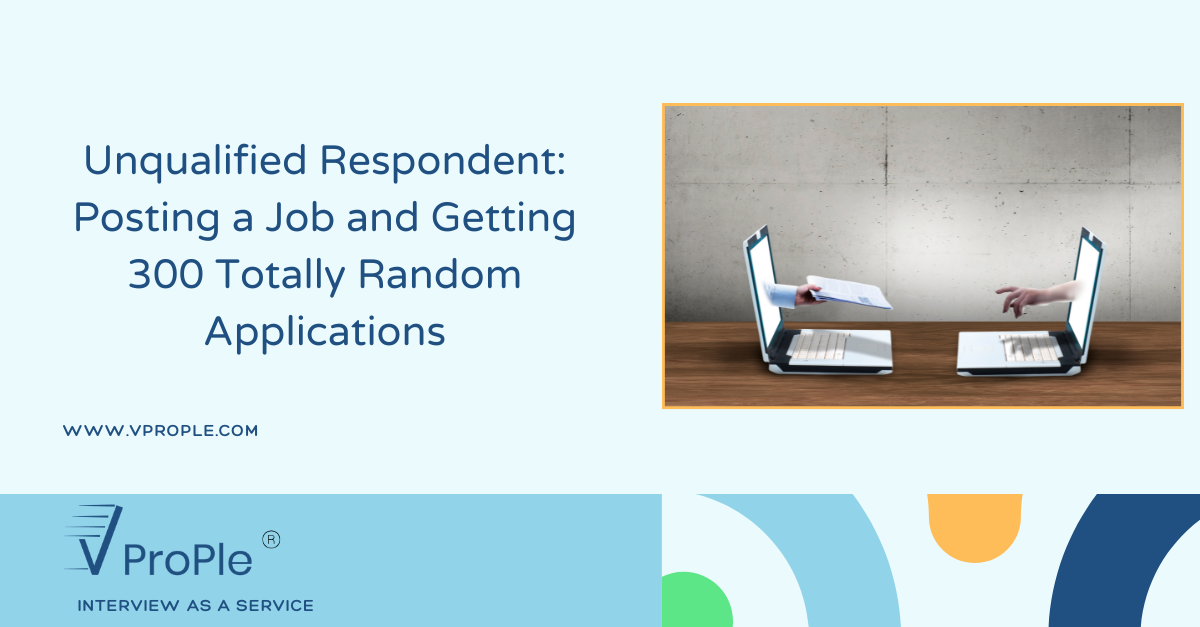This website use cookies to help you have a superior and more relevant browsing experience on the website.
Unqualified Respondent: Posting a Job and Getting 300 Totally Random Applications
-
18/10/2025

–By Lalitha Varshini
Flood of Unqualified Respondent: When you post a job online today, you often end up getting 300 totally random applications, many of which are utterly mismatched. This flood of unqualified respondents is a common challenge in modern recruiting, mainly caused due to easy-apply features, resume bots, and mass submissions. In this blog, we’ll dig into why this happens, what the numbers say, and how to sift through the noise to find real candidates.
Unqualified Respondent: 250 Applicants, Only a Handful That Fit
In the digital age, a single job ad can attract hundreds of applicants, with many of them having a chance of being irrelevant. According to hiring metrics from 2024, employers now receive an average of about 180 applicants per hire. Some sources even suggest that a single job posting commonly receives around 250 applications, though only a fraction are suitable. To understand this in a practical world, if only 1 in every 20 or 1 in every 50 applications is well-suited, recruiters may easily see 200–300 poor matches before they get to the handful they care about.
How Many Applications Does It Take to Get One Interview in 2025? We Analyzed 27 Studies To Find Out
But why so many irrelevant applicants? What causes this flood of applications in the modern-day job market?
- One-click submissions: Many job boards, platforms, and mobile apps offer one-click or “quick apply” features. This reduces friction for applicants, so even those who aren’t well qualified may throw in a resume in hopes of getting a response.
- Resume bots and scraping tools: Some job seekers use automation or mass distribution tools to submit dozens or hundreds of applications automatically, with minimal or no customisation. This inflates the volume without increasing quality.
- Blind submissions: Applicants often apply to any job whose title or description roughly matches a keyword in their resume, even if their actual skills, experience, or location don’t truly align. This increases the number of random applications.
- Irrelevant candidates: Many people keep stale resumes circulating on job sites and respond to every alert. Some candidates may no longer be actively seeking or may have changed fields.
- Listings not intended to hire immediately: Some job postings are “ghost” or phantom listings, posted not because an employer has an urgent need, but to gauge the market, collect candidate data, or look busy. It’s estimated that at least 1 in 5 job postings might never actually be filled.
Further Reads: Challenges Faced by Recruiters in Hiring
Companies do not benefit in situations like these, when they receive a huge number of applications. Such volume-driven hiring practices are very risky for the longevity of the company. While volume sounds good in theory, there are real downsides if not managed properly. They include:-
- Time drain: Sorting 300 resumes manually is costly in recruiter hours. That time could be utilised in other, more productive activities.
- Low candidate experience: often, the number of vacancies is much less than the applicants. Hence, many will never hear back, damaging the employer brand.
- Bias errors: In a rush, recruiters may reject good candidates or overlook diversity due to monotonous hiring practices that may be very draining.
- Overdependence on ATS: Rigid filters may discard good people who phrase things differently.
- False positives: Many applicants may look passable on paper, but underdeliver in interviews or performance.
Now that we are aware of why recruiters receive such a high number of applicants, let us see a few strategies to turn the random applications into a strong shortlist.
- Add screening questions: Inclusion of 2–3 mandatory pre-screening questions like “Do you have 3 years in X?” or “What is your notice period?”. That way, recruiters force applicants to reflect, and many will self-opt out.
- Require a custom response: Asking for a one-sentence answer to a domain-specific question, or a mini exercise. Applicants who copy-paste generic resumes will often skip or fail it.
- Use weighted ranking: Recruiters may assign scores to key attributes such as skills match, relevant experience or seniority.
- Leverage referrals: Instead of waiting for randoms, actively asking for employee referrals or searching the internal database proves to be helpful. Referred candidates often have higher quality and conversion.
- Stagger publishing: Instead of blasting the vacant job everywhere at once, releasing it to a trusted network first, or via smaller channels, then opening it broadly later is an effective strategy. This gives recruiters a chance to capture quality candidates before the noise.
- Use analytics & feedback loops: Tracking stages keenly, like how many apply, drop off, fail screening, get interviewed, rejected, and hire, is another crucial method. Adjusting filters, screening questions, or posting channels accordingly can prove results.
- Manage expectations with communication: Send auto-acknowledgement emails. Let candidates know when the window is closing. Even a short rejection note is better than silence.
Further Reads: Gamification in Hiring: How Gamification is Changing the Hiring Process
Let us understand a few key takeaways.
- Don’t shun volume, but don’t rely on it either.
Volume is inevitable; design the system to channel it, not drown in it. - Screen early and often.
Use disqualifiers, short tasks, and logic so that no time is wasted on clearly mismatched or irrelevant resumes. - Optimize the job ad and posting strategy.
The more precise and targeted the role, the fewer random applications that will be attracted. - Mix inbound and outbound sourcing.
Don’t just wait for applications; proactively search, request referrals, and network. - Track metrics and adapt.
Continually refine each stage of hiring to keep up with the dynamic market functioning and ever-changing trends. - Be kind to the brand.
Even applicants who are rejected are a part of the overall employer brand. Hence, communicate, acknowledge, and close loops.
Read our latest blog: POV: You’re Reading 500 Résumés That All Say ‘Team Player’
In conclusion, getting 300 totally random applications for one job post isn’t a sign that the hiring process is broken. In reality, it’s a sign of how the digital job market works today. With one-click applies, résumé bots, and mass submissions, quantity has replaced quality. But the smart recruiter’s edge lies in filters, focus, and follow-through. When hiring companies use well-crafted job descriptions, strategic screening, and data-driven shortlisting, that mountain of mismatched résumés can actually become a valuable dataset, revealing trends, candidate pools, and even future prospects.


